|
-
21st January 09, 11:58 AM
#1
The Effects of Kilt Yardage on Body Heat Loss
The Effect of Kilt Yardage on Body Heat Loss in a Cold Environment
Introduction. Among persons who wear kilts, especially those who dwell in higher latitudes, the relative warmth of various kilt styles is an oft-discussed topic. Recent threads in the online forum “X Marks the Scot” (www.xmarksthescot.com) have in particular debated the relative merits of eight-yard, knife pleated kilts (aka, “tanks”) and four-yard, box-pleated kilts. The present study was undertaken in an effort to quantify the relative heat retention of these two garments, hopefully to finally provide an objective and scientifically valid answer to the question “Is an eight-yard wool kilt warmer than other kilts?”
“Heat” is actually a measure of molecular motion; the faster the molecules, the higher the recorded temperature. All insulative materials have one feature in common, that being the ability to slow down the transfer of molecular motion (i.e., heat). The ability of a material to resist heat transfer is commonly referred to as “R value”; the higher the R value the better the material serves as an insulator. Typically, R value is significantly affected by both the molecular structure of the insulator, and the amount of air trapped by the insulator. Traditional home and pipe insulators function by trapping a layer of air between the inner and outer environments, and being themselves poor conductors of molecular motion. As the traditional (and still commonly used) material for kilt construction is wool (the hair of the domestic sheep, Ovis aries), and since wool has an excellent and well-deserved reputation for being an excellent insulator (i.e., relatively high R value), two kilts, constructed of wool but containing different amounts of fabric, were compared. A third kilt constructed of 60% polyester and 40% cotton was also included in the study to serve as an outgroup comparison.
Materials. Three kilts were used in this study. The first kilt was a deeply knife-pleated kilt (31 pleats) in the Montreat Scottish Society (NC) tartan. The cloth is 16-ounce wool fabric, fully lined with cotton, and pleated to the red stripe. This kilt contains 7.80 running yards of fabric (see fig. 1).
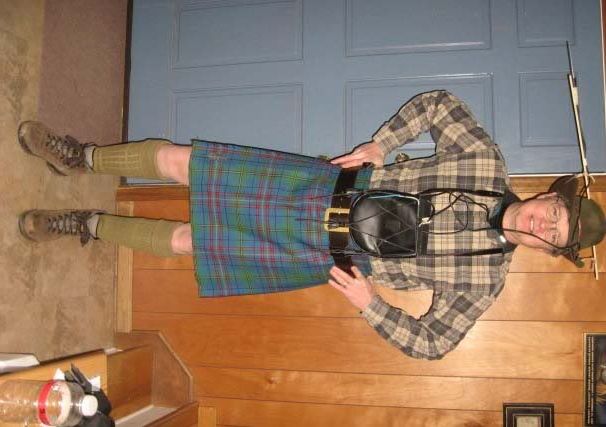
Figure 1. Montreat Scottish Society 8-yard 16-ounce wool kilt.
The second was a box-pleated kilt made of 16-ounce wool in the Carolina tartan. This kilt contains exactly four running yards of fabric, box-pleated (nine pleats) to the white stripe, and is also fully lined with a single thickness of cotton cloth (see fig. 2). Both kilts measure 25 inches from the selvedge to the top of the waistband.
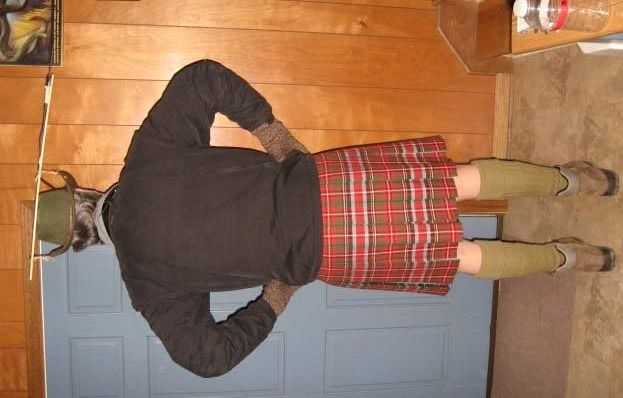
Figure 2. Carolina tartan 4-yard box-pleated 16-ounce wool kilt.
The third kilt was an unlined poly/cotton hiking kilt in Tigerstripe camouflage, 24” long, and knife pleated (15 pleats).
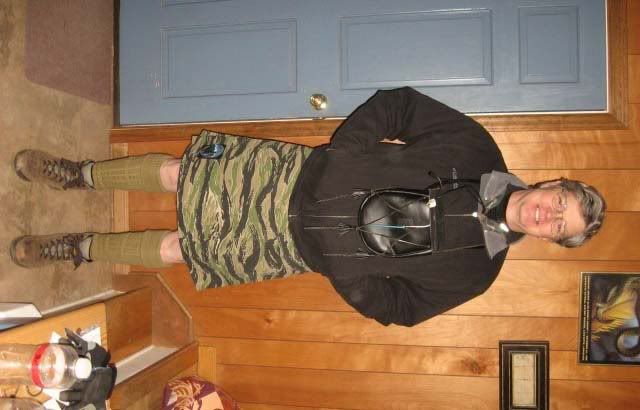
Figure 3. Tigerstripe camouflage polyester/cotton blend knife-pleated kilt.
To record temperatures, a “LabQuest” portable data recorder (Vernier Software and Technology, Beaverton, OR, USA) was employed. This battery-operated device is capable of recording data from up to four sensors simultaneously, storing the data, performing basic graphical and statistical analysis, and uploading collected data to a computer (both Mac and PC platforms are supported). Three stainless steel temperature sensors were connected to the LabQuest. Pre-trial tests indicated that the three probes were calibrated to within 0.1 degrees C of one another.
Temperature probes are capable of ascertaining the temperature of gases, liquids, or solid-surface contacts. Since the goal of the experiment was to compare the environments within the kilts, it was determined that sensor-to-skin contact was to be avoided, but that contact between sensor and the inner lining of the kilt was unavoidable. To this end, two sensors were sewn to a pair of cotton boxers (fig. 4). The boxers were worn in the same position throughout the study, so that the sensors remained in the same position relative to the researcher’s body. One temperature probe was located along the midline of the rear of the boxers and the other was located 2 inches to the wearer’s right of the midline of the front of the boxers.
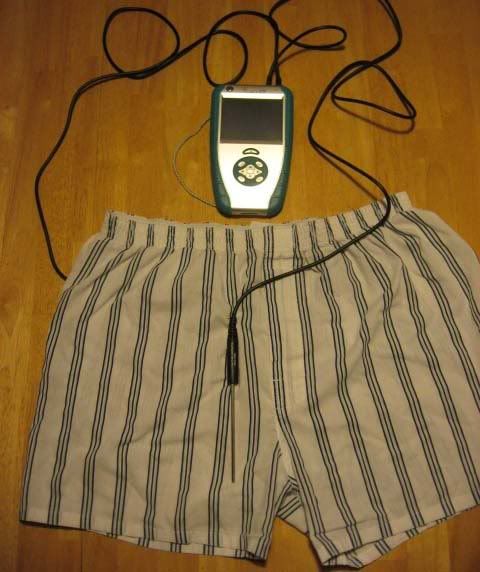
Figure 4. Boxers with two temperature sensors attached.
To record ambient temperatures, a third sensor was mounted to a wooden dowel, approximately one meter in length, to avoid conductive and radiant heat transfer from the researcher’s body. The dowel was attached to a brown, wool fedora. During the test period the LabQuest unit was stored in a leather sporran hung around the researcher’s neck. (see figures 1 and 3)
Questions and hypotheses. It is obvious that the amount of insulative fabric present in the rear of an eight-yard kilt is approximately twice that of a four-yard kilt. That being the case, and all other factors held constant, it is only reasonable to expect heat transfer to be slower through the fabric in an eight-yard kilt. However, since both garments are open to the environment, does this free air exchange negate the effect of fabric thickness in the actual temperature of the air within the kilt? (i.e., what is the validity of the reply “Hot air rises” when a kilt-wearer is asked if he is cold?). Therefore, the first hypothesis under scrutiny is that there will no difference, or perhaps a slight but statistically insignificant difference, in air temperature in the rear of the wool kilts, but that both will be warmer than the poly/cotton kilt. Since all three kilts have comparable amounts of fabric in the front, it would seem probable that the temperatures recorded in the fronts of the wool kilts would also be insignificantly different, leading to a second hypothesis which states that there will be no significant difference between the temperatures recorded in the fronts of the wool kilts, but that both would be warmer than the poly/cotton kilt.
Another important factor is to be considered is air movement. It is obvious that air trapped within a semi-enclosed space will be more rapidly evacuated and replaced with air from the surrounding environment if either or both of these air masses is moving. Therefore, the heat retained within a kilt will be affected by the movement of the air around it, within it, or both. This certainly comes as no surprise to anyone who has worn a kilt for any length of time whatsoever. But how does walking-induced air movement affect the retention of heat within kilts of varying construction? After considerable thought, and several drams of single-malt MacCallum, the principle researcher concluded that once walking was introduced as a variable, the advantage of extra yardage (if there was one at all) would be reduced or totally negated. Further consideration (and at least one more dram) resulted in the proposistion...ppropasishun...propazishun...idea that perhaps the additional lateral pendular movement (hereinafter, “swish”) of the heavier kilt might actually exchange the air within the garment more efficiently, thereby losing heat to the environment even more rapidly than would a kilt with more a modest swish factor. The procedure was, therefore, modified to test the hypothesis that walking would actually result in a decrease in the relative temperature of the air within the heavier kilt.
Procedure. On the night of January 16, 2009, the principle researcher (hereinafter, me or I or some other personal pronoun...third-person is so stiff and I just don’t have the energy to keep that up any longer) donned (very carefully) the sensor-equipped boxers. The decision to conduct this research after dark hinged on the slower temperature changes typical after sunset relative to the daytime hours and to avoid the possibility of differential warming of the kilt fabric via infrared solar radiation. (It also reduced the possibility of the neighbors having even more reason to talk trash about me.) My legs were covered with a pair of WPG khaki kilt hose and a pair of brown, insulated leather hiking boots. The kilt hose were pulled up in direct violation of the pull/scrunch rule, but considering the time of day and the low ambient temperature the presence of kilt police was judged to be unlikely. My torso was covered with a North Face expedition-weight undershirt, an LL Bean “tartan” flannel shirt (egad!), and a Columbia short insulated jacket. Wool gloves and the afore-mentioned temperature-sensing fedora completed the experimental outfit. Utilizing a coin-flip, the eight-yard kilt was chosen as the first kilt to be tested.
Meteorology: Skies partly cloudy. Winds very light (estimated 0-4 km / hr) from the West/Northwest. Ambient temperature at the beginning of the trials was -2.1 degrees Centigrade.
I stepped outside and turned on the LabQuest unit. All three probes were set to record the temperature in degrees C four times per minute for 15 minutes.
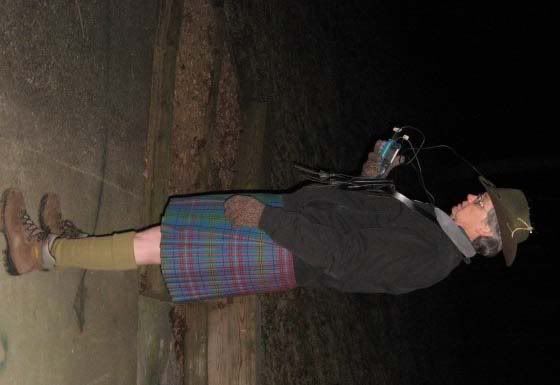
Figure 5. Data collection.
Last edited by Tartan Hiker; 25th May 10 at 06:15 PM.
Kilted Teacher and Wilderness Ranger and proud member of Clan Donald, USA
Happy patron of Jack of the Wood Celtic Pub and Highland Brewery in beautiful, walkable, and very kilt-friendly Asheville, NC.
New home of Sierra Nevada AND New Belgium breweries!
-
-
21st January 09, 12:01 PM
#2
Effects of Kilt Yardage on Body Heat Loss: Part 2
Procedure (cont'd). By observing the real-time readings of the LabQuest unit it quickly became apparent that even the slightest breeze was significantly affecting the temperature within the kilt. After trying several different locations, I finally settled on standing in my semi-enclosed firewood shed to shield my body from the breeze. Since the shed is an enclosed space of approximately three meters by four meters, and has half-walls on three sides, not to mention the thermal inertia exerted by several thousand pounds of firewood, I judged as negligible the affect of my body heat on the temperature of the ambient air within the shed.
I next discovered that five minutes was not a sufficient acclimation period. By extending this acclimation period to ten minutes the temperature changes occurring within the kilt slowed to an insignificant rate, and data collection could commence. After activating the LabQuest unit I stood perfectly still for exactly ten minutes as determined by the timer display on the LabQuest unit. At the end of this ten minute period I began to walk at average walking speed; not a quick march but fast enough to illicit a decent swish. Not wishing the local constabulary to be summoned to check out “the guy walking around in the dark with a kilt and a stick protruding from his head”, I walked up and down my driveway (a distance of approximately 25 meters). I walked for exactly five minutes in this manner (operating under the assumption that five minutes of muscular exertion would not significantly increase my body temperature), then ended data collection and stored the data in the LabQuest’s memory. With all possible haste, resisting the temptation to warm myself by the cheerfully glowing wood stove, I swapped kilts and returned to the outdoors, where the procedure was repeated with the four-yard kilt, then with the poly/cotton kilt.
Results. All raw data collected during the study are presented in graphic form in figures 6, 7, and 8. Table 1 contains a summary of the data as well as analytical data derived from the raw temperature readings. In all three graphs, rear temperatures are in red, front temperatures are in blue, and ambient temperatures are in green.
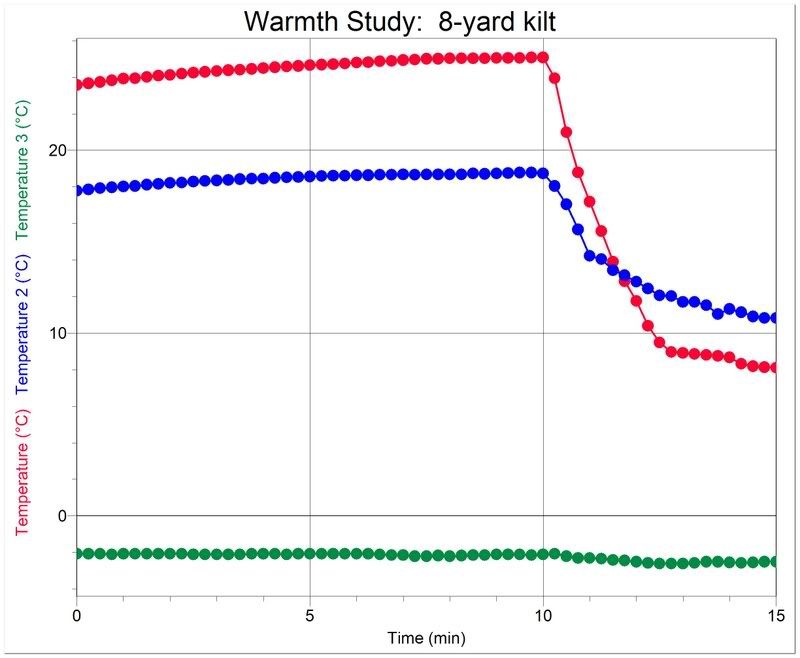
Figure 6. 8-yard kilt data.
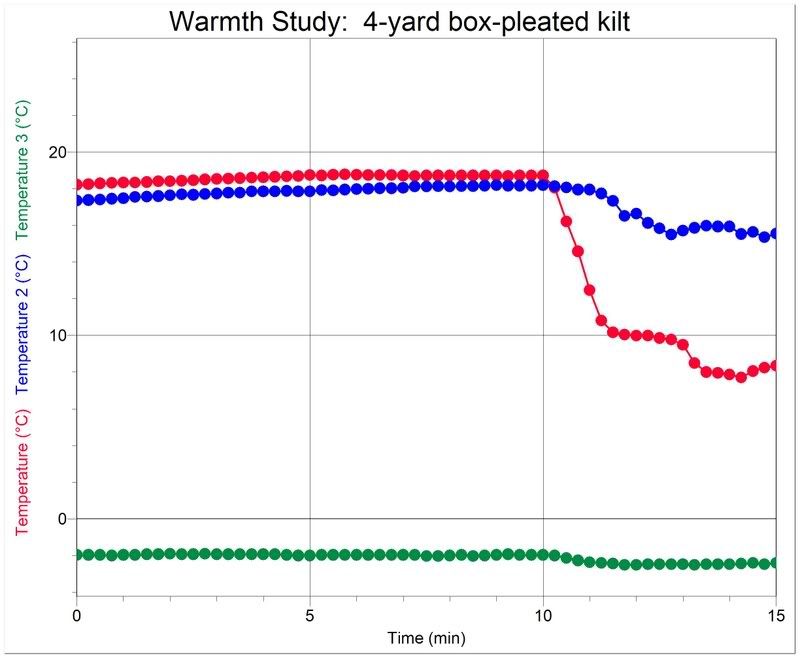
Figure 7. 4-yard kilt data.
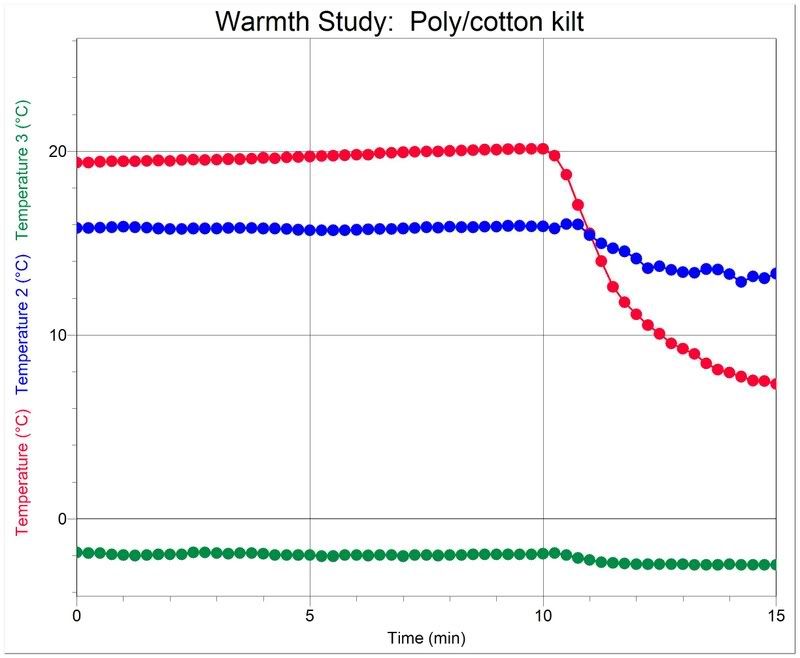
Figure 8. Poly/cotton kilt data.

Table 1. Derived data.
(* all temperatures in this table are expressed in Centigrade degrees above ambient temperature)
(** final rear temperatures were calculated by averaging the five temperatures collected in the last 1.25 minutes of the walking period.)
(*** total temperature loss was calculated by subtracting final walking temperature from average standing temperature)
(**** per cent temperature loss was calculated by dividing total temperature loss by average standing temperature)
Last edited by Tartan Hiker; 22nd January 09 at 02:35 PM.
Kilted Teacher and Wilderness Ranger and proud member of Clan Donald, USA
Happy patron of Jack of the Wood Celtic Pub and Highland Brewery in beautiful, walkable, and very kilt-friendly Asheville, NC.
New home of Sierra Nevada AND New Belgium breweries!
-
-
21st January 09, 12:02 PM
#3
Effects of Kilt Yardage on Body Heat Loss: Part 3
Analysis
The graphed data for the three kilts can be seen in Figures 1, 2, and 3. In addition to the graphs, all data (temperature in degrees Centigrade; to the first decimal place beyond zero) were stored in tabular form. These data were used to derive the descriptive statistics located in Table 1. Note that the LabQuest collected four temperatures each minute, for a total of 61 data points in each 15 minutes test period.
Ambient temperatures. Throughout the test period, ambient temperature varied from a high of –1.8 degrees C to a low of –2.5 degrees C. Averaging all the ambient temperature data produced a mean of –2.01 degrees, and the median was exactly –2.00 degrees. Since this range was so narrow, I felt justified in using –2.0 degrees as the ambient temperature for all comparisons.
Statistical treatments. Student’s t-test of sample means was the method of choice for comparing the data derived in this study. Since the ambient temperature varied insignificantly, I was able to directly compare the temperatures (degrees Centigrade above ambient temperature, which in this case was recorded temperature plus 2 degrees), rather than calculate the differences between recorded and ambient and compare the remainders. Significance was established at p <0.05 level and high significance at p <0.01.
Examination of the derived data reveals a number of observations which are of considerable interest in this study. The following is a list of these observations, each accompanied by a brief discussion.
1. Rear standing temperature. When standing still, there was no significant difference in the average temperatures in the rear of the 4-yard and the poly/cotton kilts. The temperature in the rear of the 8-yard kilt was 5.25 degrees higher, an increase of 25% over the 4-yard and the poly/cotton.
When standing still, the air in the rear of the 8-yard kilt was 26 degrees C above ambient temperature. (That’s 79 degrees F warmer than the outside air!) Both thickness and composition affect the R value of fabrics, but the air trapped between the layers of fabric also play a significant role. With 31 deep pleats in the 8-yard test kilt, there is a considerable amount of material and dead air space, producing an exceptional insulative layer. As a result of this finding we reject the first hypothesis and accept the alternate hypothesis, that being that the 8-yard kilt is indeed warmer than either the 4-yard kilt or the poly/cotton kilt while standing still. I believe that the poly/cotton and the 4-yard compared favorably (surprisingly so) in large part due to the larger amount of trapped air in the knife pleats of the poly/cotton kilt (3” deep pleats with 1.5” reveals), as well as the multiple thicknesses of fabric (five in most places) which compensated for the poly/cotton fabric’s lower R value.
2. Front standing temperature. When standing still, the front of the poly/cotton kilt retained the least heat. The 4-yard wool kilt was warmer by 2.0 degrees, which was found to be a statistically significant difference. The 8-yard kilt was 2.4 degrees warmer than the poly/cotton. The difference between the front standing temperatures of the 4-yard and the 8-yard kilts was not statistically significant.
This finding leads us to accept the second hypothesis, that being that the 8-yard kilt and the 4-yard kilt exhibit no difference in warmth in the front while standing, but that they are both warmer than the poly/cotton kilt. The R value of the poly/cotton fabric is certainly less than that of 16-ounce wool, so in head-to-head competition, two layers of wool conserved more heat than two layers of poly/cotton. Since the construction of the aprons of the two wool kilts was essentially the same, there was no difference in their front standing temperatures.
3. Rear final walking temperature. After five minutes of walking, there was no significant difference between the rear air temperatures of all three kilts; the air temperature in all three kilts had dropped to approximately ten degrees above the ambient temperature. It is noteworthy that walking resulted in the 8-yard kilt losing 61% of its retained heat. With a 56% heat loss, the poly/cotton heat loss appeared to be less than that of the 8-yard kilt, and with a 51% heat loss the 4-yard box-pleat also lost less than the 8-yard kilt. Statistical analysis demonstrated no significant difference between the heat loss ratios of the 8-yard kilt versus the poly/cotton kilt, but did indicate that the 4-yard kilt lost significantly less heat when compared to the 8-yard.
Obviously air movement is a major factor affecting kilt “warmth.” My explanation for these data is that the extra swing generated by the mass of the 8-yard kilt’s pleated section, combined with the tendency of the pleats to open and close (“splay”) as they swing, contributed to the precipitous decline in rear temperature. Observations seem to indicate that while walking the pleats of both the box-pleated and the poly/cotton kilts do not splay as much as do the pleats in the heavier 8-yard kilt (although I have no quantifiable data to support this claim). If this is indeed the case, the air trapped between the layers of fabric would be exchanged more efficiently by the greater “bellows effect” in the 8-yard kilt, resulting in a more significant loss of heat. The more modest swing of the other kilts resulted in less air exchange, and therefore less heat loss.
4. Front final walking temperature. As was the case with rear temperatures, the front temperature of the 8-yard kilt dropped significantly more (40%) than did the front temperatures of the 4-yard and the poly/cotton kilts (11% and 15% respectively), although all these declines were less dramatic than the declines in rear temperatures.
I conclude that the bellows effect is at work here as well, and that the “flushing” of trapped air by the swinging pleats in the rear of each kilt also serves to flush warm air from the front of the kilt, albeit to a lesser extent. It is noteworthy that during the tests I was not wearing a sporran in its usual position. It is possible to speculate that heat loss from the front of a kilt may be reduced by wearing a sporran, which could serve to limit the movement of the front aprons and possibly reduce flushing of the air beneath them by the movement of the front aprons.
Last edited by Tartan Hiker; 25th January 09 at 07:39 PM.
Kilted Teacher and Wilderness Ranger and proud member of Clan Donald, USA
Happy patron of Jack of the Wood Celtic Pub and Highland Brewery in beautiful, walkable, and very kilt-friendly Asheville, NC.
New home of Sierra Nevada AND New Belgium breweries!
-
-
21st January 09, 12:03 PM
#4
Effects of Kilt Yardage on Body Heat Loss: Conclusion
Conclusions
The traditional 8-yard wool kilt is indeed warmer in the rear and while standing still. As soon as motion is introduced, the advantage of the 8-yard kilt is rapidly diminished. Within three minutes, the air temperature in the rear of the 8-yard kilt became insignificantly different from that of both of the other test kilts. I conclude that the swish that is the hallmark of a heavy kilt serves to flush the air from beneath and from between the pleats, thus in large part negating the increased R value of the fabric when compared to lighter garments. Indeed, all kilts apparently lose most of the heat retained in the pleated section once walking motion is introduced. This study also demonstrated that while walking, the 4-yard kilt (and the lightweight poly/cotton kilt!) retained more heat in the front than did the 8-yard kilt, again, the bellows effect apparently trumps the insulative value of the material itself. These findings indicate that if you are walking in cold air, and with all other factors held constant, a 4-yard box-pleated kilt may keep you warmer than an 8-yard knife-pleated kilt.
In the initial phases of data collection it became obvious that wind, in this case even a very light breeze, significantly affected the retained heat within a kilt. The effect of wind may not be directly comparable to the effect of walking, since the motion induced by wind does not typically result in a rhythmic swinging of the pleats. It would be interesting to conduct further tests on the effects of wind, but that would require a controlled environment (a wind tunnel or some other well-controlled wind source), and after standing in –2 degree C temperatures for nearly two hours, the last thing I wanted to do was to stand in front of a fan. Clearly wind results in a loss of heat from beneath a kilt, and my best guess is that, at least in light to moderate winds, this loss would be significant regardless of kilt material and construction. Further study is warranted to answer this question.
Of particular note is the difference in standing front and standing rear temperatures within each kilt. In both the 8-yard and the poly/cotton kilts, the difference between these two temperatures was significant (see figures 6 and 8), but the difference between front and rear temperatures in the 4-yard kilt (figure 7) was statistically insignificant. Indeed, front and rear temperatures in this kilt were nearly identical. Matt Newsome, Curator of the Scottish Tartans Museum, kiltmaker, and advocate of the box-pleated kilt style, has written in several articles that the box-pleated kilt, having similar amounts of material in the front and rear, is a more “balanced” kilt than is the more common 8-yard kilt. The results of this study provide objective, numerical support for this assertion.
Can the results of this study provide insights into the relative merits of the three kilts in summertime temperatures? Kilt wearers know that the bellows effect does work effectively in flushing warm air from beneath a kilt in warm weather, assuming that the wearer is indeed walking. The effect of sunlight, especially on darker-colored materials, would play a significant role as well. These questions could be easily answered with a follow-up study conducted during warmer weather conditions, and I may indeed be conducting this research at a later date (assuming anyone really wants to know how hot it gets under a kilt while standing in the sun in front of a clan tent at a Highland Games event in July). Perhaps some questions are better left unanswered.
Acknowledgements: First and foremost, X-Marks members piperdbh and Howard Clark suggested this as a topic for serious research. My fondness for the Mythbusters television show, and all the wonderful gadgets they invent to test various urban myths, played a pivotal role in the design of this study. Finally, I acknowledge the support of my loving wife and two sons, who didn’t laugh (well, they did laugh a little) when given this grand opportunity to make sport of my latest craziness. My youngest son did take most of the photographs.
For a printed version of this article on high-gloss paper, refer to the Journal of Geriatric Kilting, vol. 37, pages 34-51. The video didn’t turn out too well, so the planned YouTube version of the testing procedure is, unfortunately, not available.
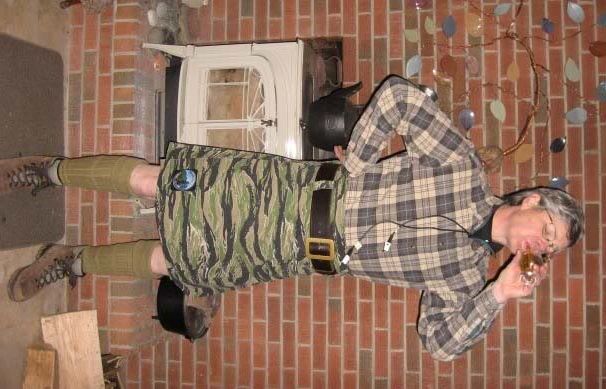
Warm at last! CHEERS!!!!
Last edited by Tartan Hiker; 21st January 09 at 08:30 PM.
Kilted Teacher and Wilderness Ranger and proud member of Clan Donald, USA
Happy patron of Jack of the Wood Celtic Pub and Highland Brewery in beautiful, walkable, and very kilt-friendly Asheville, NC.
New home of Sierra Nevada AND New Belgium breweries!
-
-
21st January 09, 12:26 PM
#5
I congratulate you on a finely executed and well-presented study.
I was rather surprised by the heat loss incurred when walking; I didn't think about the pleats splaying. Could you feel the temp. change as you walked, or was it so cold outside that a few degrees either way didn't make much of a difference?
I plan to print this when I get home (my school computer firewalled your pics) and reread it. I'm especially keen to see the thermodora you were wearing.
You have contributed much new knowledge to the worlds of science and kilting, and I'd like to be the first to raise a glass to your honor. May you take your place among Kepler, Galileo, Newton, Bunsen Honeydew, and other great thinkers of the ages.
Now, good luck getting that equipment back to school before the principal reads this.
--dbh
When given a choice, most people will choose.
-
-
23rd January 09, 09:48 AM
#6
 Originally Posted by piperdbh

I congratulate you on a finely executed and well-presented study.
You have contributed much new knowledge to the worlds of science and kilting, and I'd like to be the first to raise a glass to your honor. May you take your place among Kepler, Galileo, Newton, Bunsen Honeydew, and other great thinkers of the ages.
Now, good luck getting that equipment back to school before the principal reads this.
Bah on Bunsen, Beaker is the true genius.
-
-
21st January 09, 12:28 PM
#7
Magnificent!
We are clearly in your debt.
Any thoughts on the possible varying effects of humidity differences (I'm thinking desert verses seacoast) or considerations of divergences due to changes in elevation?
Did I forget to say I'm impressed?
Have you heard from the Noble people yet?
Matt H.
Insperata Floruit! - Flourished Unexpectedly!
KABOOM; Kilted Christians; Kilted In Carolina; Matt Newsome Kilt Owners Group; R Kilts are Awesome; SEKS - The Great Southeastern Kilt Society; The Order of the Dandelion
-
-
21st January 09, 12:44 PM
#8
Wonderful and masterful piece of original research.
I really think this should be submitted to the Annals of Improbable Research (http://en.wikipedia.org/wiki/Annals_...bable_Research). Has the makings of an Ig Noble Award as well. (http://en.wikipedia.org/wiki/Ig_Nobel_Prize).
Certainly brightened up the day!
Brian
In a democracy it's your vote that counts; in feudalism, it's your Count that votes.
-
-
21st January 09, 12:48 PM
#9
That was very well done. I bet you were really glad to think of attaching the sensors to boxers instead of trying to attach them regimentally with duct tape...
For your next project might I suggest...
Which kilt turns the most lasses' heads?
You'll need to test non-traditional, casual and traditional, box and knife pleats, in a wide variety of tartans.
Alternatively, which kilt gets you the most free beer in pubs?
Daft Wullie, ye do hae the brains o’ a beetle, an’ I’ll fight any scunner who says different!
-
-
21st January 09, 12:55 PM
#10
Excellent piece of original research. 
-
Similar Threads
-
By ChromeScholar in forum General Kilt Talk
Replies: 5
Last Post: 6th January 08, 03:42 PM
-
By souzaphone711 in forum General Kilt Talk
Replies: 30
Last Post: 23rd March 07, 11:47 AM
-
By freddie in forum Kilt Advice
Replies: 3
Last Post: 1st April 06, 10:14 PM
-
By toadinakilt in forum General Kilt Talk
Replies: 2
Last Post: 30th July 05, 05:07 PM
 Posting Permissions
Posting Permissions
- You may not post new threads
- You may not post replies
- You may not post attachments
- You may not edit your posts
-
Forum Rules
|
|

































Bookmarks